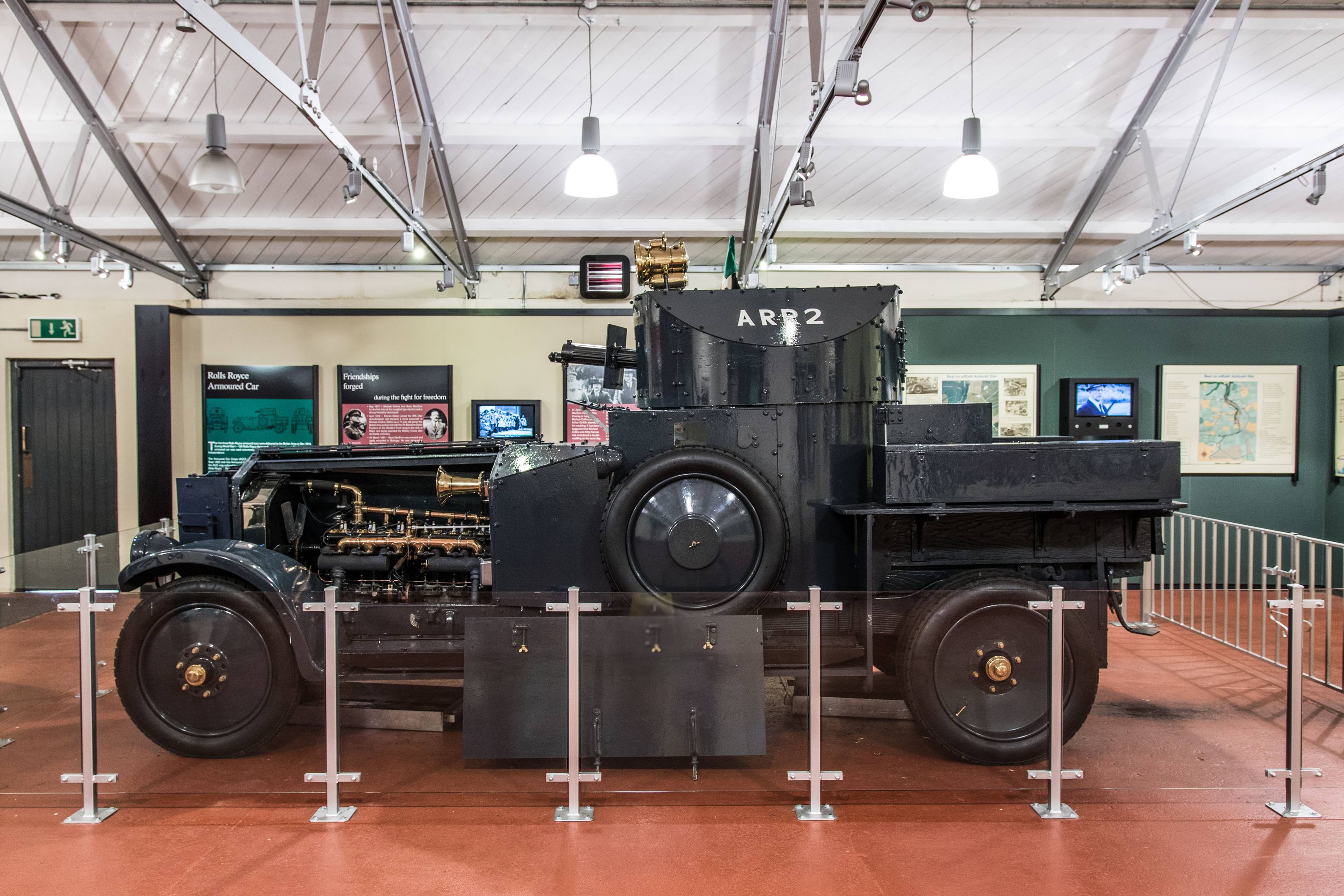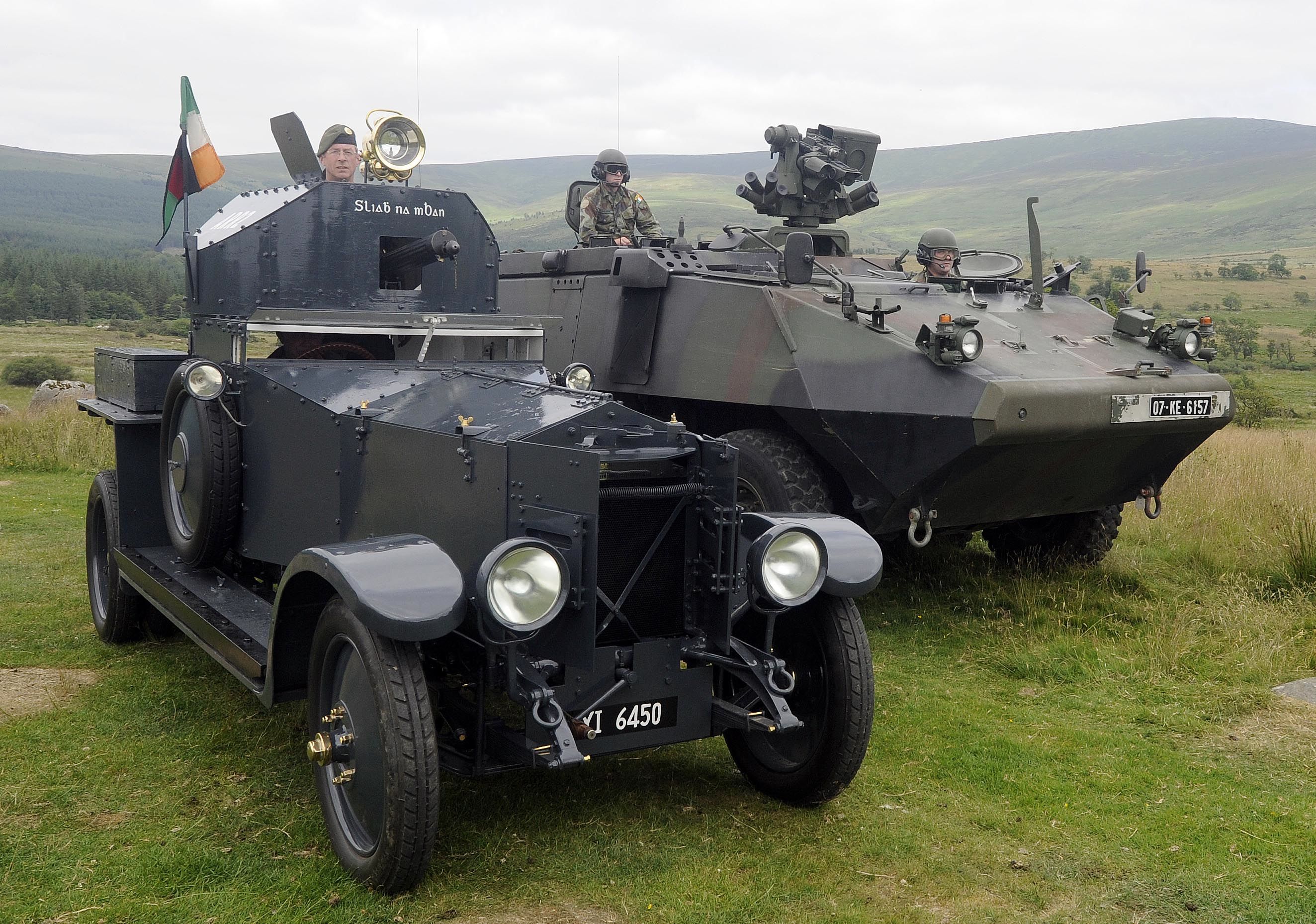Irish Army’s armored Rolls-Royce is a Ghost of battles past
Béal na Bláth, County Cork, Ireland, 1922—The trap was set, the riflemen lay in ambush. General Michael Collins, of the Irish Free State Forces, rocked gently in the passenger seat of the Leyland Crossley tender, unaware that he was driving into an ambush and his doom. Behind him, a massive protector hummed and clanked, part steel and part Judas.
Nearly 100 years later, that same beast rolls to a stop and moves its enormous plate-steel turret several degrees clockwise. The gunner takes aim, feeding a round into the chamber. The belt-fed Vickers .303 barks to life once more, firing the heavy slugs at a rate of 450 rounds per minute. Dust kicks up from the berms at the tank range, and when the firing is done, this ancient war elephant trundles forth with a triumphant air. It has proved its battle-worthiness for another year.
This is Sliabh no mBan, the oldest wheeled active-service military vehicle in the world. Think of it as the internal-combustion equivalent to the USS Constitution. Owing to the rules of the Irish Army, Sliabh no mBan must remain on active duty in order to receive the funding necessary to keep her rolling. She is thus no museum piece, but a fully functioning weapon, subject to all the same requirements as any of the other tanks or armored cars in the Irish Army’s motor pool.
Sliabh no mBan survives only because a crafty Irish quartermaster kept the hulk on the books as scrap metal and covered it with a tarp. As its sister cars were torn apart and melted down, It sat for decades until being rescued and restored over a three-year period.


She is fully restored to like-new condition, save that there are still bullet strikes on her carapace from that fatal ambush. Further complicating her history, she is known to have fought on both sides of the Irish Civil war, as shortly after the assassination of Collins, her gunner turned coat to the anti-Treaty forces. Her gun went suspiciously silent while the General and his forces were under fire. There persist dark rumors of betrayal, sabotage, or worse.
The Irish Civil War is an oft-overlooked conflict, so to have this link to the past is priceless. Even more important is that Sliabh no mBan is the last of her kind; while there are other armored Rolls-Royces in the world, almost none of them are in running condition, and certainly none in such original shape. It is the last survivor of one of the noblest pieces of machinery ever made.
I arrive at James Black’s restoration shop, about 20 miles southwest of Belfast, just in time for a cup of tea and a biscuit. Then again, there’s always time for tea and a biccy in Northern Ireland. Black is a specialist in the Rolls-Royce Silver Ghost, and while there are a few other machines on the premises, most of the chassis here have a long pedigree. Perhaps none has a longer pedigree than the long frame currently occupying the main restoration shop, which is more like an English Lord’s library than a garage. Parked amongst glass-fronted display cabinets filled with brass-bound Rolls-Royce parts is the winning car from the 1913 Alpine Trials—the victory that allowed Rolls-Royce make the claim to be the “best car in the world.” A grueling endurance rally held in the mountain passes of the Austrian and Italian Alps, the Trials tested cars to their limits. Rolls-Royce specially prepared this car for its privateer rally driver, fitting it with heavier-duty suspension, a four-speed gearbox, and an enlarged fuel capacity.
With the bodywork off, it’s a good way to see the bones of what would become the armored Ghost. At the beginning of World War I, a British naval officer named Charles Rumney Sampson had fitted a Maxim to his own privately owned Rolls-Royce runabout and had several successes rescuing downed pilots and harassing the German army. Spurred by these and some similar exploits by the Belgians, the British War Office ordered Rolls-Royce to begin producing armored cars based roughly on the frame of the successful Trials car.

The Ghosts were tough and durable, with 7.0- to 7.5-liter engines producing between 50-80 horsepower and plenty of torque. Despite being hugely heavy, they were capable of around 70 mph. In a time when a cavalry unit was still using horses, the armored Ghost was capable of lightning strikes.
In the desert, Lawrence of Arabia would deem them more valuable than rubies. His team of armored machines disrupted the much larger Turkish forces, creating a new textbook for desert warfare. Similarly, the Duke of Westminister led a daring raid to free captured British sailors along the coast of Africa. His nine-car spear destroyed the enemy with fire and fury, then sped back across the desert.
In Ireland, 13 armored Ghosts were given to the Free State Forces by the British government. The partition of Ireland into south and north led to a great deal of upheaval, and both sides in the Civil War were experienced in guerilla warfare. The Ghosts, which the Irish called “whippets” for the speed, were a foreshadowing of the mechanized blitzkrieg of WWII.
Apart from the tires, they were practically indestructible. The restoration process required fitting stanchions for the original brass search lamp. The first drill broke. A second drill was custom built. It broke, too. Eventually, the stanchions were welded on. Even after a century, the arsenic-treated boilerplate steel couldn’t be pierced.
Armored ghosts would be part of the shore defense during the Battle of Britain and would last even longer into conflicts in the desert. However, one by one they fell into disuse, as modern, faster equipment replaced them.


Today, Sliabh no mBan sits in pride of place at the Curragh Museum, near the Irish Army’s main barracks. Like many of the exhibits, it’s tucked behind glass, but this one is different. The back half of the display is hinged, and one wall is an enormous bay door, ready to roll up at a moment’s notice.
As a display, Sliabh no mBan is immensely valuable. But more important are the days when she sallies forth again, a crew of specially trained soldiers at her helm and weapon. She is the past come to life, that it may never be forgotten.



I’m currently working on an article about the use of armoured fighting vehicles in the Irish Civil War (1922-23) for the submission to The Irish Sword: The Journal of the Military History Society of Ireland. I appreciate Brendan McAleer’s fine article about the Sliabh no mBan (prior to the 1960s the Anglified version of the name, Slievenamon, was used). Two points I’d like to address. It’s commonly stated that the National Army (rechristened the Irish Defence Forces) obtained thirteen Rolls-Royce armoured cars from the British Government. However, the author Ralph Riccio has pointed out in his excellent study, A.F.V.s in Irish Service since 1922 (2010), that the list of thirteen, for whatever reason, doesn’t include the ‘Ballinalee’, which served mainly in Cos. Mayo and Sligo. The ‘Ballinalee’ was captured by Republican troops and renamed ‘The Wild Rose of Lough Gill’. The ‘Lough Gill was used extensively by the Anti-Treaty forces in northern Connaught until it was cornered and abandoned, though not after being damaged in an attempt to deny its further use to the National Army (it’s not clear whether it was able to be put back into service after this). The second point concerns the gunner in Sliabh no mBan, John ‘Jock’ McPeak. Not surprisingly, the failure of Sliabh no mBan’s Vickers machine gun to operate during the ambush at Beal na mBlath and the fact that its gunner, McPeak, changed sides not long afterwards have raised suspicions. The fact is, however, that the Vickers gun jammed because the ammunition belts had been loaded by inexperienced men. As for McPeak, his loyalties were shaken by witnessing the mistreatment of Republican prisoners, which led him to seek to return to him home in Scotland. He only agreed to aid the Republicans in gaining possession of the Sliabh no mBan in return for their help in smuggling him out of the country. In closing, I enjoyed reading your well researched article.